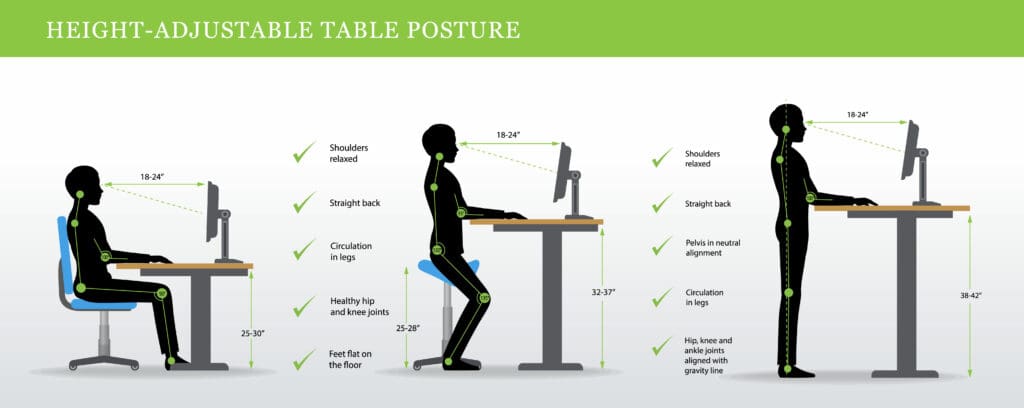The Leg Work on Sit-to-Stand Desks: Are they the Bees Knees?
By Jeffrey Sheridan MS OTR/L, Injury Prevention Specialist for PTSMC

In an office setting, the most common question PTSMC’s Employer Services department gets when performing ergonomic assessments is “Are sit to stand desks really worth it?” The answer isn’t as easy as yes or no.
Standing desks have become increasingly common in office settings as the conversation about the health impacts of prolonged periods of sitting has ramped up. Studies have found that sitting for long periods of time leads to much higher mortality rates, obesity, and problems with posture and circulation, regardless of physical activity level.
Whether you’re sitting or standing, you should ask yourself this question: is my work station set up correctly for my body?
You may be surprised to learn that it’s just as easy to increase your risk of musculoskeletal disorders (MSDs) while standing as it is while sitting if you’re not following proper ergonomic guidelines. Common issues such as having a monitor below eye level can lead to increased strain on your neck while you look down for long periods at a time. You also have reduced ability to provide support for your upper extremities (UEs) when standing. No chair = no armrests. This can add to UE strain and poor posture over time. Proper mouse and keyboard height/alignment can also be overlooked when standing. Reaching outside of the recommended zone for extended periods of time can increase the risk of injury and increase your chances of pain and other negative side effects.
Now, reading all of this, you may assume the answer to the aforementioned question is unequivocally “NO, a standing desk isn’t worth it.” Well, you’d be wrong. We believe everyone who sits for longer than four hours a day should have the option to transition to a sit-to-stand desk with the important qualifier that you follow the proper guidelines.

Proper Guidelines for Standing Desk Setup
- Back and neck straight, elbow around 90º
- wrist in neutral position
- standing mat to reduce fatigue
- a foot rest to allow offloading
Following these guidelines will create a proper workstation setup for YOU and decrease your risk of injury. We always recommend having a professional trained in ergonomics assess your station to maximize the effectiveness of your new tools. Humans were not built to do anything for eight hours a day, including sitting and standing. Being able to get out of a seated position to stretch and stand creates the opportunity your body needs to maintain proper balance. Maximizing your workstation, with a proper ergonomic sit-to-stand desk, will give you the best chance for a pain-free work environment you’re excited to come back to every morning.
The best way to ensure proper workstation ergonomics whether you’re sitting or standing, is to bring in a professional. Click here to learn about how employer services will help your employees stay injury and pain free.
